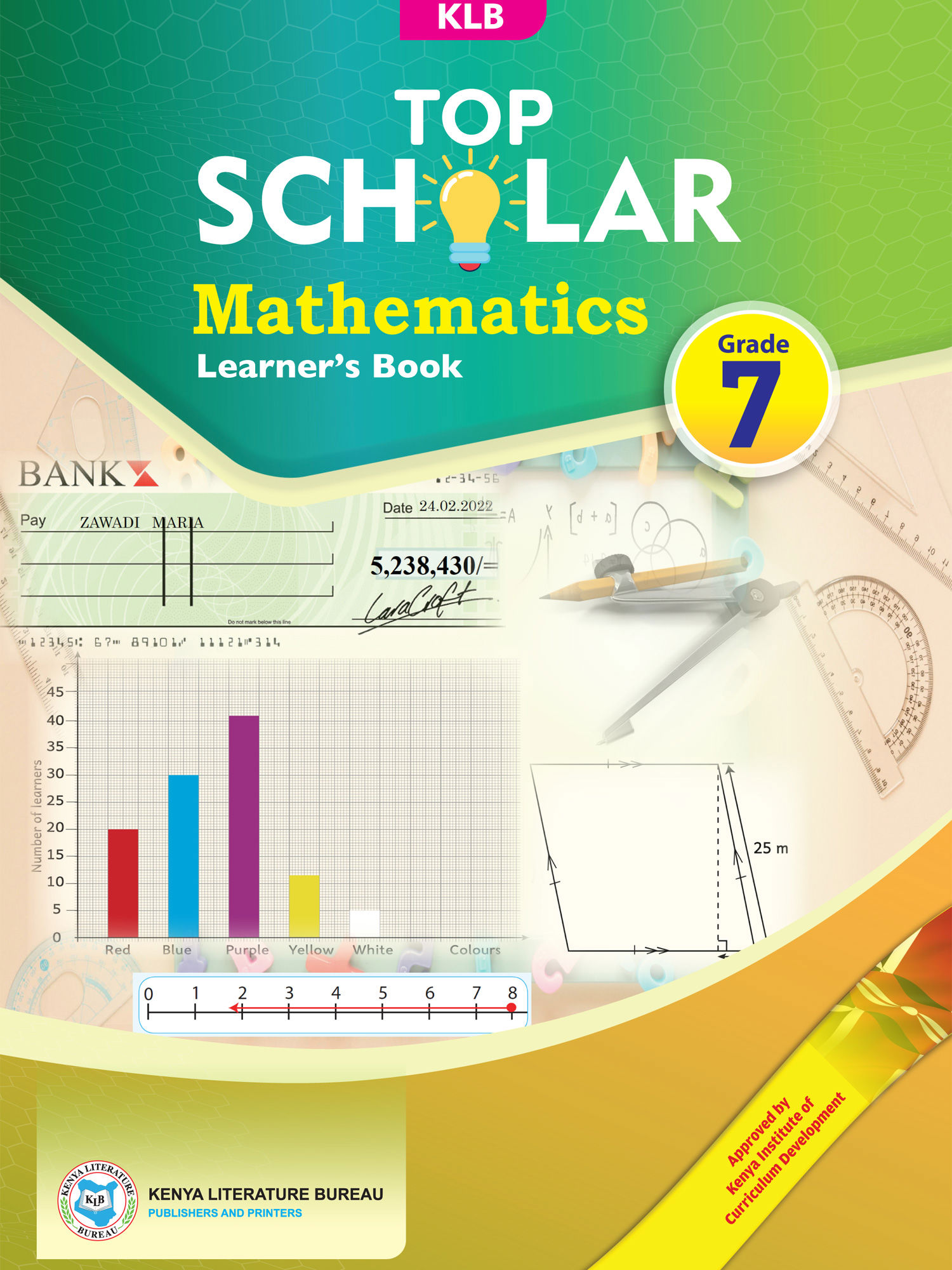
Authors
Zipporah Muli, Vincent Odhiambo, Lewis Mwalili, Jane Mbugua, Wycliffe OgemboExercises kit’s authors
Zipporah Muli, Vincent Odhiambo, Lewis Mwalili, Jane Mbugua, Wycliffe OgemboPublisher
Kenya Literature Bureau
Included in packages

-
The study kit contains 134 chapters and 638 exercises of which 536 are in the chapters and 102 in the task exercises.
-
Authors
Zipporah Muli, Vincent Odhiambo, Lewis Mwalili, Jane Mbugua, Wycliffe Ogembo -
Exercises kit’s authors
Zipporah Muli, Vincent Odhiambo, Lewis Mwalili, Jane Mbugua, Wycliffe Ogembo -
Subject
Mathematics -
Grade
Grade 7 -
Kit's language
English -
Publisher
Kenya Literature Bureau -
Included in packages
1. Whole numbers
2. Factors
3. Fractions
Lead |
Chapter |
|---|---|
| 3.1. | Comparing fractions |
| 3.2. | Arranging fractions |
| 3.3. | Adding fractions |
| 3.4. | Subtracting fractions |
| 3.5. | Multiplying fractions (1) |
| 3.6. | Multiplying fractions (2) |
| 3.7. | Reciprocals of fractions |
| 3.8. | Dividing fractions |
| 3.9. | Sequence of fractions |
4. Decimals
5. Squares and square roots
Lead |
Chapter |
|---|---|
| 5.1. | The squares of whole numbers |
| 5.2. | The squares of fractions |
| 5.3. | The squares of decimals |
| 5.4. | Square roots of whole numbers |
| 5.5. | Working square roots of fractions |
| 5.6. | Working square roots of decimals |
6. Algebra
7. Linear Equations
8. Linear Inequalities
9. Measurements
Lead |
Chapter |
|---|---|
| 9.1. | Pythagorean relationship |
| 9.2. | Applications of Pythogorean relationship |
10. Length
Lead |
Chapter |
|---|---|
| 10.1. | Conversion of units of length |
| 10.2. | Addition and subtraction of units of length |
| 10.3. | Multiplication involving units of length |
| 10.4. | Division involving units of length |
| 10.5. | Perimeter of plane figures |
| 10.6. | Circumference of circles |
11. Area
Lead |
Chapter |
|---|---|
| 11.1. | Units of measuring area |
| 11.2. | Area of a rectangle |
| 11.3. | Area of a parallelogram |
| 11.4. | Area of a rhombus |
| 11.5. | Area of a trapezium |
| 11.6. | Derivation of the formula for the area of a circle |
| 11.7. | Area of borders |
| 11.8. | Area of combined shapes |
12. Volume And Capacity
13. Time, Distance and Speed
14. Temperature
15. Money
Lead |
Chapter |
|---|---|
| 15.1. | Profit and loss |
| 15.2. | Percentage profit |
| 15.3. | Percentage loss |
| 15.4. | Discount |
| 15.5. | Percentage discount |
| 15.6. | Commission |
| 15.7. | Percentage commission |
| 15.8. | Interpreting bills at home |
| 15.9. | Preparing bills |
| 15.10. | Postal charges (1) |
| 15.11. | Postal charges (2) |
| 15.12. | Mobile money services and transactions |
16. Geometry
Lead |
Chapter |
|---|---|
| 16.1. | Angles on a straight line |
| 16.2. | Angles at a point |
| 16.3. | Angles on a transversal |
| 16.4. | Angles in a parallelogram |
| 16.5. | Angle properties of polygons |
| 16.6. | Exterior angles and the number of sides of a polygon |
| 16.7. | Solving angles and sides of polygons |
17. Geometrical Constructions
18. Data Handling And Probability
Lead |
Chapter |
|---|---|
| 18.1. | Meaning and collection of data |
| 18.2. | Frequency distribution table |
| 18.3. | Suitable scales for graphs of data |
| 18.4. | Pictographs of data |
| 18.5. | Bar graph data |
| 18.6. | Interpretation of Bar Graphs |
| 18.7. | Pie Charts of data |
| 18.8. | Interpretation of Pie charts |
| 18.9. | Line Graph of Data |
| 18.10. | Interpretation of travel graphs |
